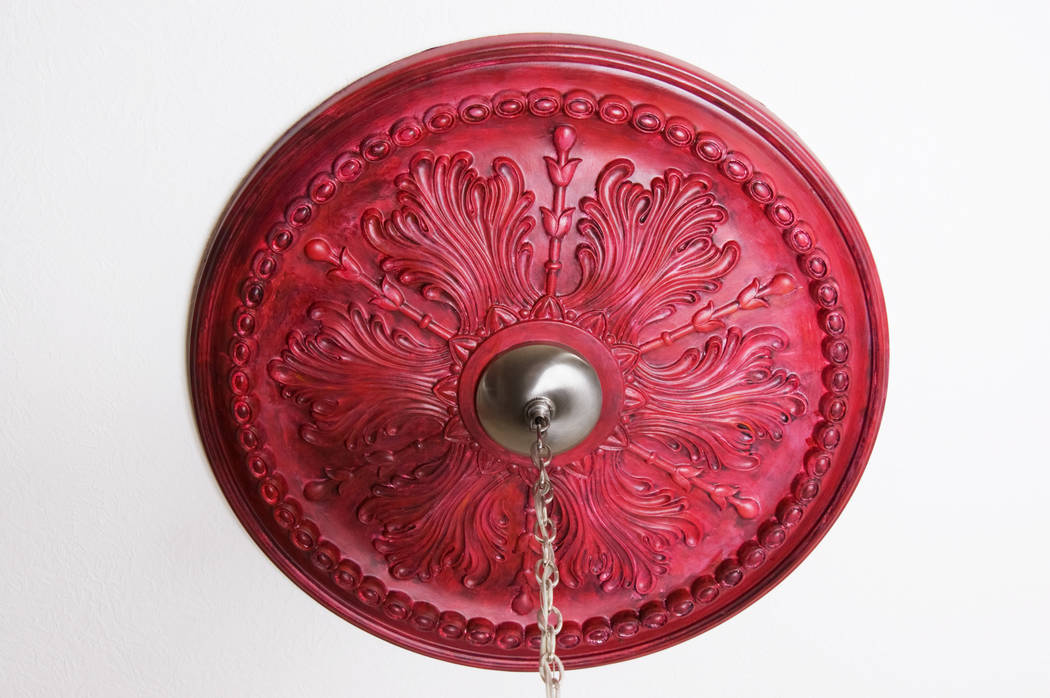Medallion can hide gap around newly installed chandelier

Q: My husband replaced a chandelier in our dining room. The problem is that the fixture he removed had a larger base than the new one he installed, which covered the hole in the ceiling. He is not good at drywall repair and so he hung the light anyway and it looks really stupid with a gap around the base of the chandelier. Should we just caulk around the gap or what?
A: Kudos to husbands like yours. Maybe he doesn’t have all the skills necessary, but damn the torpedoes and full steam ahead. Don’t you dare tell him it looks stupid as it will damage his fragile ego. Lots of wives call us to get things done before the weekend when their husbands will have a chance to screw it up. Instead, suggest that he put a medallion around the base of the new fixture.
Medallions are a great way of drawing attention to an otherwise boring ceiling or light fixture.
For the most part, medallions are inexpensive and easy to install. They are made of plastic or polyurethane and may be painted.
They usually come in one piece, which means you will have to take the light fixture down only to reinstall it again. Others come in two halves. You can then screw it to the ceiling, fill the holes and paint it.
Ceiling medallions come in a variety of sizes ranging from about 12 to 36 inches. The size you should choose depends on the size of your fixture, the size of the room and the height of your ceiling. A general rule is to choose a size that is different from the size of your fixture, either larger or smaller.
To install a one-piece medallion, you must remove the light fixture (turn off the power to the fixture first). The fixture will have three wires connecting it to the power in the ceiling, and these connections will be secured by wire nuts. Unscrew the wire nuts and separate the wires.
The fixture will be held to the ceiling by a mounting bracket that supports the fixture with either a threaded rod or screws. Remove the fixture.
Center the medallion over the junction box and trace a light pencil line around it. The medallion may already have a hole cut in the center, but you will likely have to expand it with a hole saw, scissors or other cutting implement. Just make sure you don’t cut a hole that is larger than the base of your light fixture so that the base will cover the hole.
For the inexpensive plastic medallions, you can spread some construction adhesive on the back and smoosh it against the ceiling so that it fits within your pencil marks.
For the larger medallions, you can still use construction adhesive, but you should drill some holes into the medallion so you can screw it to the ceiling for added support.
Make the holes so that they end up somewhere on a flat surface of the medallion. You don’t want to drill a hole in a curved profile or a groove because you will have a hard time filling in the hole so that it is unnoticeable.
Use coarse thread drywall screws and tighten until snug, but don’t overtighten. You will have to countersink the screws and then fill in the holes and sand it smooth.
Lay down a thin bead of caulking around the perimeter of the medallion and then paint it. You may want to paint the medallion before you install it, and then just touch up the screw holes.
You can then re-hang your light fixture, but you may need a longer threaded rod to make up for the thickness of the medallion.
This project should help your husband preserve his masculinity and you will look like a hero for suggesting it.
Mike Klimek is a licensed contractor and owner of Las Vegas Handyman. Questions may be sent by email to handymanoflasvegas@msn.com. Or, mail to 4710 W. Dewey Drive, No. 100, Las Vegas, NV 89118. His web address is www.handymanoflasvegas.com.